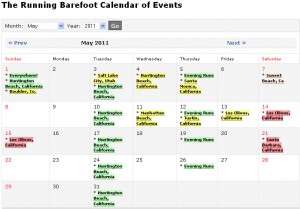Contents
Schedule
Following a schedule to increase distances over a certain period is not unlike advancing from one grade to the next based on a time table, rather than on whether or not the student is ready to move to the next grade (though sadly this is often the case in schools).
When we run any “long” distance, learning something new is difficult. Rather than experimenting and playing and trying to figure out how to run, we tend to run the way we’re most comfortable running (just to achieve the short-term goal of finishing this run), that is the way we have always run before, or something very similar (a way to run which was most likely learned while wearing shoes).
So like the student trying to “get through” this semester, we spend less energy learning, and more energy just trying to survive the pain and embarrassment of getting low grades.
Actual Learning
Listen to your body, listen to your soles, before moving on to a new distance … don’t even try running any distance until you have re-learned how to run barefoot (start out with standing barefoot, then walking barefoot, preferably on an uncomfortable/stimulating surface first).
It’s difficult to experiment with anything except the most minor adjustments while actually running, especially if we are set on covering a certain distance, even worse if we’re set on covering that distance in a certain time. We need to free ourselves to play with various ways to move, varying our techniques to test these movements and techniques beyond the “sweet” spot. Because if we don’t go beyond the sweet spot, we can never be sure if we’ve even come close to the sweet spot.
We need to be able to play, and if we have a set goal of a set distance, and set goals of increasing those distances over a set time, there is little room for play!
Essentially, we should be taking the basic techniques that seem to work for most people, and have been tested personally by me and millions of others over many eons, and fine tune them for each individual body, as that body changes, evolves, even gets injured and heals over time (for example, some people with leg length discrepancies from traumatic accidents are successfully running barefoot, because of the interactive feedback that is unique to barefoot running), and with each and every day, over various terrains, with each and every step.
Posted in: Preparation

